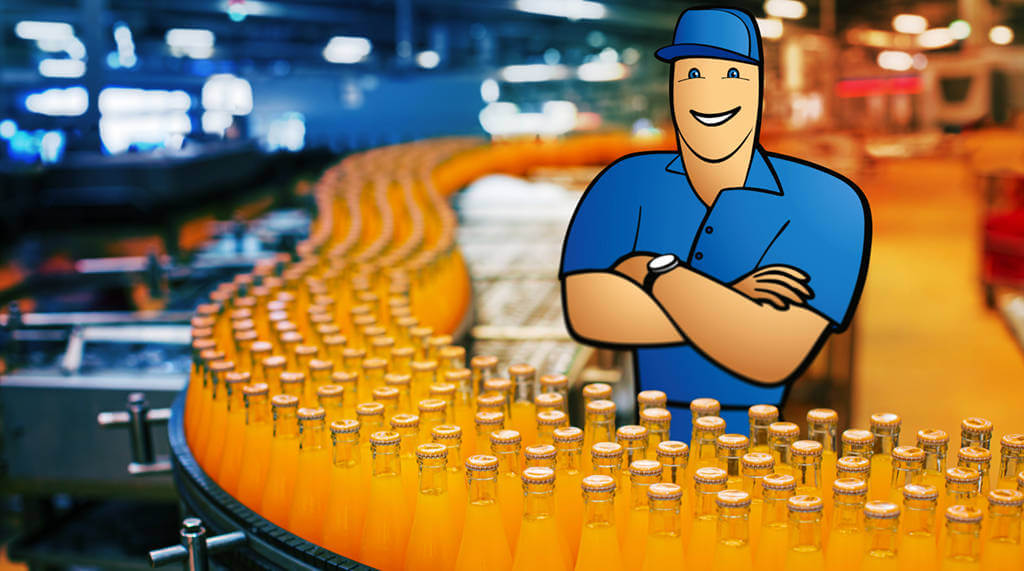Production Optimization – A Simple Guide for SMEs
The realm of production optimization is as diverse as there are different manufacturing workflows. Optimizations can range from changing inventory and warehouse layouts to adopting machine learning and advanced AI. In this post, we look at the basics of production optimization with a focus on how small manufacturers can optimize their processes.

You can also listen to this article:
What is Production Optimization?
Production optimization is the process of systematically addressing faults and deficiencies in a manufacturing operation in order to increase efficiency and productivity. It can refer to any number of activities that manufacturers employ to hasten production flow, eliminate bottlenecks, and reduce waste. The methods of optimizing production are endless, ranging from optimizing the warehouse layout or work-in-process (WIP) inventory and utilizing production management software to implementing cellular manufacturing or backward scheduling, training employees, etc.
Remaining competitive and profitable in any manufacturing industry depends largely on constant effort toward less waste, more productivity, and optimal efficiency. This goes especially for small manufacturers who need to navigate tight profit margins.
These reasons are why production optimization often goes hand in hand with continuous improvement – a crucial tenet of business process management, including lean principles like Kaizen and production models like Just-In-Time.
There is no one proper way in which systematic production optimization should be approached. The field of manufacturing types, models, processes, and so on is simply too vast. However, typical key phases in one form or another include discovery, process analysis, implementation, and measuring results.
Production vs process vs product optimization?
Production optimization should not be confused with process or product optimization. Whereas the former attempts to create a more efficient system to produce goods, the latter two deal more with identifying and remedying process-specific deficiencies and designing more efficient-to-produce goods from the ground up. Let’s take a closer look.
What is process optimization?
Process optimization means raising the efficiency of a specific process in a product’s routing. Whereas production optimization deals with optimizing the sequence, resource allocation, or production flow of and between manufacturing processes, process optimization is designing the processes themselves to be more efficient.
Imagine a manufacturing workflow for a table producer. Tabletops move into assembly to have legs attached. The assembled table is then taken to the paint shop and after painting and drying, the table moves to post-processing where varnish is applied. The table is then dried once more and the product is given a final polish.
An instance of production optimization would be to apply the varnish in the paint shop instead of moving it to post-processing for varnishing. This would eliminate the need to keep two sets of drying racks on the shop floor, thus decluttering the shop floor and reducing equipment costs. However, an instance of process optimization would be to develop a painting method that would enable applying varnish without having to dry the paint beforehand.
What is product optimization?
Product optimization is a process wherein products are designed to be more efficient to produce in the first place. In other words, the optimization is confined to the product’s design. This means designing the product in a way that would enable eliminating or modifying certain steps in its manufacturing process to increase throughput without negatively affecting the product’s marketability.
Product optimization leads to reduced production lead time and production costs, a shorter or more streamlined supply chain, etc. It may also add value if changes to the product design increase its marketability without decreasing production efficiency, i.e. increasing its lead time or production cost.
Continuing with the above table example, an instance of product optimization would be to choose a type of paint that doesn’t need extra varnishing, use a varnish that doesn’t need polishing but is as smooth to the touch, etc.
Production optimization methods
As mentioned earlier, there is no one right way to optimize production. Deficiencies depend greatly on specific manufacturing workflows, workstation sequences, shop floor or inventory layouts, labor skills, etc.
Simply rotating one machine at its workstation could suffice in decreasing a product’s cycle time. Or maybe all shop floor workers need complex training in order to reduce material waste. The scale and nature of necessary changes can vary hugely from process to process.
There are different approaches to the optimization process as well. One might be to hire a consultant who benchmarks the manufacturing system and produces an audit. Another would be to brainstorm ideas with the production team on how to systematically improve efficiency.
A third one might be to enable the Internet of Things (IoT) in the production line by adding sensors to workstations and utilizing machine learning algorithms and artificial intelligence to detect issues through process analysis software.
Basic production optimization checklist
Although it’s difficult to generalize, systematic optimization should include at least the following steps in one form or another:
- Track processes and gather data. The key to a successful optimization effort lies in gathering accurate and relevant data on the preconditions of the manufacturing processes, supply chain performance, labor efficiency, etc. There needs to be a good overview of the situation.
Next to IoT or benchmarking software, one highly cost-efficient way to go about this is by implementing manufacturing software. These systems automatically generate data-driven reports and statistics, providing you with system-wide traceability. They can be an excellent means of detecting previously unseen bottlenecks and other issues while increasing overall efficiency.
- Identify issues and analyze deficiencies. Once data about the production system is aggregated, it’s time to analyze it to detect problems. There are many methods available. A tried and tested approach is performing a root cause analysis. Here, the underlying issue is identified and traced back to its source instead of addressing the spot where the fault was detected in the production process.
Other reliable means of detection include bottleneck analysis which helps to identify constraints and blockages within processes that are slowing down the production line, and downtime analysis in which real-time data on machine utilization is analyzed to detect discrepancies in machine cycles to identify underlying causes.
- Assign goals and KPIs. Once you have identified any issues, the next logical step is deciding what to do about them. Fixing everything at once could require huge investments and not be feasible, while other issues might stem from external events or supply chain disruptions difficult to control. Roadmaps should be deployed and plans made for how, when, and by which measure you are going to address the issues.
Insight into the exact performance hits of various deficiencies can help with prioritizing and decision-making. A great way to help with this is through tracking efficiency-specific Key Performance Indicators (KPIs). Examples include First Time Through (FTT), Mean Time Between Failure, Mean Time to Repair, Production Schedule Attainment, and many more. KPIs assist not only in measuring efficiency but can also provide an early-detection system.
- Implement improvements and measure results. This last step consists of adopting and implementing the various improvements the optimization audit has unearthed. Solutions here can be as diverse as the issues underlying them, so generalizing is difficult. It is critical, however, to inform and coordinate everything with stakeholders and train employees on all the necessary changes.
Another crucial aspect to consider is adopting continuous measuring techniques. While the optimization process might be complete, installation means automatically detecting future issues. Production software such as a competent manufacturing ERP system can also be invaluable for ushering in continuous improvement. This software enables seamless data collection and automation, often including efficiency-centric dashboards and predictive analytics tools while simplifying production planning.
The importance of production optimization
Naturally, routine or continuous production optimization brings a plethora of potential benefits to manufacturing companies, helping to snuff out redundancies and increase operational efficiency.
Here are some of the major benefits of production optimization:
- Decreased lead time. Most production issues like bottlenecks, poorly set up workstations, or delays from poor communication between departments will reduce flow rates or throughput. These situations mean lead time will inevitably take a hit and seriously affect the company’s profitability and competitiveness. This is why decreasing lead time is among the top priorities of optimizing production workflows.
- Less waste and smaller overheads. Manufacturing waste is not just wasted materials but any amount of effort that customers are unwilling to pay for, be it time, energy, or resources. Time and cost are interconnected in manufacturing. The longer it takes for raw materials to become finished goods, the higher the factory overheads in the form of utility bills or machine depreciation. It all boils down to lost business opportunities. Production optimization can remedy all of the above.
- Higher product quality. Inefficient processes not only waste time but can directly affect product quality. Internal failures or deficiencies plaguing the manufacturing process drive up the Cost of Quality as defective items must be reworked, extra resources allocated to processes, etc. By addressing this and ensuring better processes, production optimization leads to higher-quality products.
- Better access to production data. While needing some initial investment in the form of installing sensors or implementing manufacturing software, digital production optimization methods present a shortcut to the digital transformation of hitherto spreadsheets-based workflows. A partially digitized or better yet – entirely paperless manufacturing operation leads to increased visibility of production data and an overall more modern manufacturing process, capable of reaping the benefits of the automation promises of Industry 4.0.
How can manufacturing ERPs help optimize production?
Implementing an MRP system or manufacturing ERP can be the number one solution for SMEs to increase their overall efficiency and optimize their production processes. This software provides a centralized platform for managing all aspects of manufacturing operations while giving clear insights into performance.
Manufacturing ERPs track production schedules, inventory levels, and resource utilization in real-time. This simplifies identifying bottlenecks and inefficiencies. By automating routine tasks and providing detailed analytics, ERPs also make data-driven decision-making about resource allocation and production planning accessible and easy to grasp. Since ERPs operate via a unified database, they also facilitate collaboration between different departments and teams, enabling better communication and coordination across the production line.
Implementing a manufacturing ERP system can provide SMEs with the tools they need to optimize their production processes, increase efficiency, and fortify their competitiveness.
Key takeaways
- Production optimization systematically addresses faults and deficiencies in a manufacturing operation in order to increase efficiency and productivity.
- Production optimization is distinct from process optimization and product optimization. Whereas the former attempts to create a more efficient system and workflow to produce goods, the latter two deal with identifying and remedying process-specific deficiencies and designing more efficient-to-produce goods from the ground up, respectively.
- There are different ways of approaching optimization. It can be conducted as a one-time audit or implemented as continuously. Optimization can be undertaken internally, bought as a service from consultant companies, or implemented through adding sensing data to workstations, implementing IoT, or software.
- The basic steps of production optimization in one form or another include tracking processes and gathering data, identifying and analyzing issues, assigning goals and KPIs, and implementing improvements.
- Significant benefits of production optimization include decreased lead time, less waste and smaller overheads, higher product quality, and better access to production data.
Frequently Asked Questions
Production can be optimized in any number of ways. For example by better positioning sequential workstations, remapping production schedules, changing warehouse layouts, training shop floor workers to reduce material waste, etc.
There are different ways of approaching optimizing production. One might be to hire a consultant who benchmarks the manufacturing system and produces an audit. Another would be to brainstorm ideas with the production team on systematically improving efficiency. A third option would be to enable the Internet of Things (IoT) in the production line by adding sensors to workstations to detect issues through manufacturing software.
– Track processes or implement system-wide traceability and gather data.
– Analyze the data and identify the issues.
– Prioritize results and assign optimization goals.
– Implement improvements and monitor results continuously.
You might also like Capacity Planning – An Essential Guide for Manufacturers




